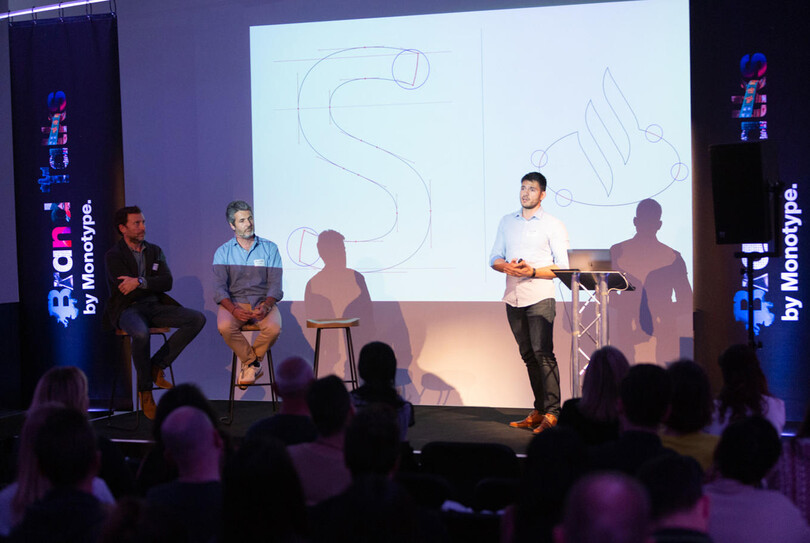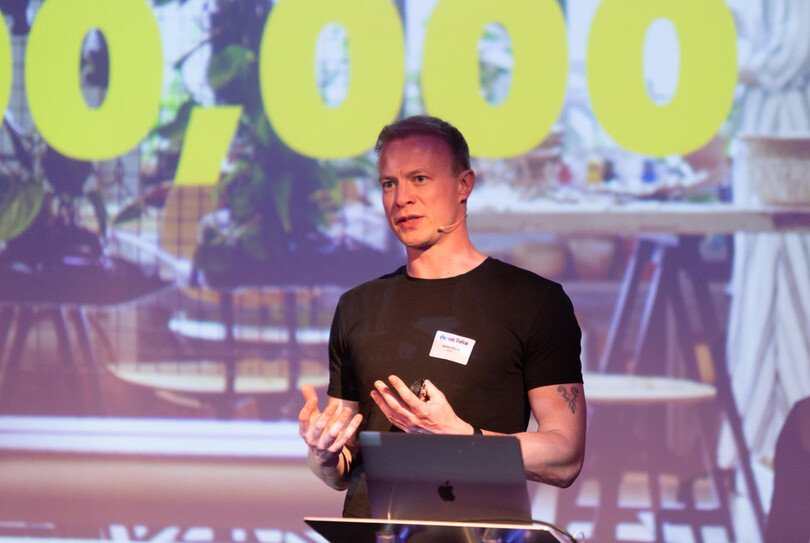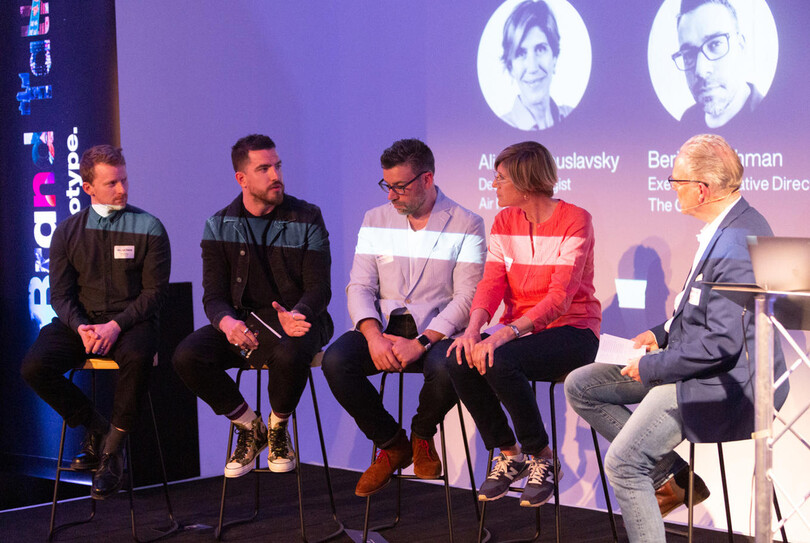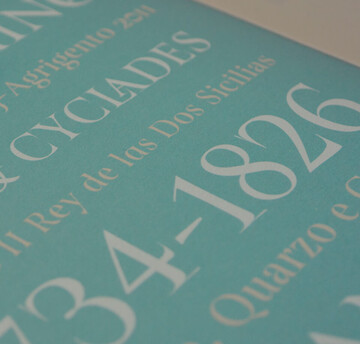Brands built for the future: A recap of Brand Talks London 2019.

“Some say that branding is not as important [today], but I’d argue it’s never been more important. It just needs to be applied in the right way.”
This quote came from Simon Gill, Chief Experience Officer at Isobar (part of Dentsu Aegis Network agency), and was one of the several key takeaways from last week’s Brand Talks London, an event hosted by Monotype. Held at Shoreditch Studios, in the heart of one of London’s most artistic neighborhoods, Brand Talks featured a full day of speakers from leading global brands and agencies who discussed the primary factors influencing brand identity in a modern world.
While several themes echoed throughout the panels and presentations, three that emerged as particularly notable were the need to:
- Maintain a consistent brand identity
- Communicate with customers in more authentic ways
- Develop a strategy to future-proof your brand
Maintain a consistent brand identity
It’s no secret that today’s consumers are engaging with brands in more places than ever before. With technologies like voice assistants, augmented reality, and the internet of things continuing to mature, brands will need to consider how to create experiences that can connect across an increasingly disparate buying journey.
Juan Erquicia, Group Brand Manager for Santander, spoke about the financial organization’s rebrand, designed to engage its global audience in more consistent ways. With roughly 144 million customers spread across the world and a myriad of different business units for both personal and commercial banking, it was important that Santander develop a brand identity that could be consistent everywhere but flexible for the needs of each individual market.

The brand worked with its agency, Interbrand, to undergo a comprehensive brand reform. Interbrand’s Executive Creative Director, Borja Borrero, and Senior Designer Lucas Machado shared the full scope of development that went into producing a truly consistent brand for its client. The process included balancing the color pattern; updating the famous “flame” logo for digital environments; and developing iconography and imagery that was consistent but featured people with varying skin tones and looks, either thinking or on the move to align with the brand’s vision of helping people achieve their dreams. Santander also worked with Monotype to develop a new custom logotype, moving from a serif to a sans serif.
After all of that, Santander realized there was one missing component, and worked with Monotype to develop a brand font as well: “Santander headline, Santander text,” empowering even greater consistency for its new brand identity. Check out the below video to learn more about the brand’s new typeface.
In another session, Lin Chiang-Hui, Staff Creative Designer, Corporate Branding and Tan Peiling, Senior Creative Designer, Corporate Branding at Alibaba Group spoke about how consistency in branding led to the development of Alibaba’s new corporate typeface, Alibaba Sans. The company developed the typeface alongside Monotype and offered it free of charge to the many independent vendors that use its platform.
“We want a typeface that doesn’t just speak to our consumers, but also our internal employees,” Chiang-Hui noted during the presentation. “We gave our teams hundreds of keywords and asked them to pick out 10 that resonated with Alibaba’s identity.” Some of the words that stood out for employees were “dynamic,” “dependable,” “youthful,” “passionate,” and “strength,” and the team used these keywords to govern their new identity.
For Alibaba, consistency in language was of particular importance as the company continues to expand its footprint globally. Latin and Mandarin characters had to appear as a family, and Alibaba Sans was designed to cover 172 distinct languages. To learn more about Alibaba’s new typeface, check out our case study.
Communicate with customers in more authentic ways
Today’s consumers want to buy from brands they trust and that align with their values. In a session led by Jason Black, Web Communications Manager, UK & Ireland at IKEA and Ali Peacock, Growth Executive at Olapic by Monotype, the pair explored the need for a new kind of visual imagery to more honestly communicate with audience segments.
“In terms of authenticity and market relevance, we find that user-generated content plays a big role,” Black told attendees. IKEA, he said, has produced more than 200,000 content assets using an in-house agency, so the team is not short on content. But working with Olapic to deploy a UGC strategy allows the company to add unique value in its messaging and show a more accurate representation of its customers lifestyles.
As Black noted, the IKEA buying journey includes exploring, filtering, and eventually buying. “UGC helps us fulfill the need for the consumer at each stage,” he said.

A healthy user-generated content strategy involved co-creating experiences with customers, which meant ceding some of the creative control that brands traditionally retain in their marketing. Black conceded that when IKEA first broached the idea of UGC, many in the company were hesitant. And so, the team took a “test-and-learn” approach, which demonstrated impressive results:
- 8/10 top-performing organic posts on social were from user content
- 27% higher reach than owned organic social
- 2.7x higher engagement with user content on the homepage when compared to owned content
In order to be successful, IKEA needs to spend time in people’s homes learning about their lifestyles and their preferences. Black shared that by deploying a UGC strategy, the team now has a way to scale that research and do it in a less intrusive way, turning it into powerful insights for both marketing and product development.
In another session, Jacqui Browne, a visual designer and Harry Ashbridge, a writer for the financial services brand Monzo, discussed the importance of building an authentic relationship with customers. Monzo has developed a reputation in London and beyond for having a conversational approach to its brand, a refreshing difference for customers who are weary of the highly-regulated and often confusing financial industry.
According to Ashbridge, the team achieves this by picking places where it can be more bold and engaging, without sacrificing the need to stay consistent with the style of the financial sector. As he put it, “there is a difference between being serious and being formal.”
For example, when the team debuted a new account offering, they emailed a poem instead of a standard marketing communication. This unexpected approach got more attention and appreciation from customers, including one who responded with (to paraphrase) “This has convinced me to upgrade, but I’m tempted to wait so that I can receive more of these fun emails.”
As Simon Gill from Isobar succinctly put it, “Today, brands are more than what they say, they are what they do.” Gill shared an incredible example of Volkswagen, a brand aligning with the purpose of its customers. Reacting to a report from The Daily Mail that said 7 out of 10 children are now glued to their devices while in the car, the automaker created an interactive campaign to engage the imagination of children in the Netherlands. Partnering with noted children’s book authors who wrote hundreds of modular stories to map to the roadways of the Netherlands, Volkswagen and Isobar created an app utilizing augmented reality to get children thinking creatively during a ride in the back of the car.
This kind of thinking is helping brands get closer to their audiences and build trust beyond purchase.
Develop a strategy to future-proof your brand
In an ever-changing world, brand leaders must be considerate not just about the needs of today but the direction of tomorrow. Several leaders touched on the idea of future-proofing a brand, including during the aptly entitled panel, “Change is Constant: How to Future-Proof Your Brand.”
“People [today] have different expectations than prior generations,” said Beri Cheetham, Executive Creative Director at The Gate. “Many agencies haven’t adapted to the desires of millennials.” He called out the movement toward creating a better workplace for working mothers as one positive change that will help brands be more sustainable long-term. He also shared research that showed employees are more productive at the beginning of the week, and less productive at the end. In response, some companies are now closing on Wednesday, which is making Thursday and Friday feel instead like Monday and Tuesday. This change is making people happier and increasing productivity overall, a true win-win.
Alicia Bogouslavsky, Design Strategist at Air France, also commented on the need to address employees in a future-forward strategy. “[At Air France], we provide a place where people feel encouraged and safe to work in a different way. We have incorporated a design mindset, which is the key to designing the future,” she said.
Bogouslavsky noted that many of the future changes in aviation and in the broader travel category are coming from traveler preferences and regulators, especially in regards to concern for the environment, but that brands can also take an inside-out approach to evolving their cultures.

“Employee experience is the new frontier of driving results from the inside-out,” explained Bogouslavsky. “Employee experience is not just human resources, it’s communication, it’s everything you do that touches your day to day work.”
This relevancy has to be authentic, as Tom Foley, Type Director for Monotype cautioned. “Trends promote innovations, but you need to understand and identify what part of a trend is appropriate for a brand,” he said.
The truth is, future-proofing your brand requires an intense focus on good design. Tom Hind, head of photography at BBC Studios finished off the day by sharing The Business Value of Design, a report by McKinsey that demonstrated how strong design correlates with better business performance.
“We need to justify ourselves more than ever in the creative industry,” he told the audience. Hind also cited Netflix as an example of a company that is leaning into the importance of design. The streaming giant’s animated “N” that precedes any original programming was likely designed in part because consumer research studies had indicated artwork was the biggest influencer to a member’s decision to watch content.
Of course, for a brand to be successful in the future, it needs to build strong relationships with its audience, now. According to Hind, “better imagery unequivocally increases engagement and empathy.
Thank you to everyone who participated and attended Brand Talks London. If you couldn’t attend, check out all of the presentations today.
Monotype hosts several of these events globally, so contact us today if you’d like to learn more or would like to talk with us about how to create a more consistent, authentic, and future-proofed identity for your brand.








